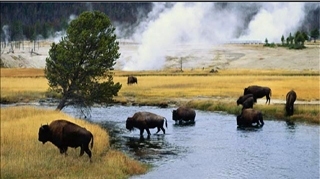|
Kearney Women’s Club House
More about the Kearney Women’s Club
Started in 1888 – By 1898 – 74 members
Invited husbands to 10th annual banquet, at the Midway
November 27th [Thanksgiving??]
Menu began with Rockaways [it was a type of carriage but food?????]
Typical Thanksgiving meal
Ended with:
Assorted cake
Chocolate &
vanilla ice cream
Coffee
Cigars [for
men only?]
Community Projects (not a complete list) -- What do they do besides meet?
Basically 4 areas: Civic, Culture, Education & Children – all local
Civic – for the good of the city
Plantings –
Planted trees
in 3rd Ward park; carried water to them
Planted a
tree on Longfellow school grounds for each Kearney soldier killed in WWI
Planted trees
in Centennial Park
Planted trees
and roses in Harvey Park
Maintained a
rose garden at the cemetery for many years
Moved to Club House yard when cemetery needed the space.
Installed drinking fountains downtown
Culture
Donated to Chautauqua fund 1906 and
later
Give music scholarships to high
school students
Education
Worked to bring the Practical Nursing
School to Kearney
Have receptions, do capping and
graduations for nursing school
Children
Conducted Tuberculosis Christmas Seal
campaign for many years
Held first baby clinic, in 1915
During depression bought shoes and
clothing for needy children
Led move to get school nurse in
public schools
From Women's Club History - Buffalo County Poor Farm
[previous information –
closing date not given, sometime about 1920]
“At a meeting in 1921 a report was
made on the county poor farm where pasture land was rented at $5.00
an acre, and cultivated land for one-third of the crop. The county
poor were cared for at the WCTU Hospital at $6.00 per week for
nursing care. The Women’s Club made donations of bedding and food.”
Charles Hanson – Builder of the Women's Club House
(House is located in the Ashland
Addition of Kearney Junction at 723 W 22nd St.)
1855 – Born in Sweden on November 19
1869 – Came to America, arrived in
Chicago, Ill. on May 25 (age 13)
The Illinois Years
1869-1874 – 5 years - Farmed
in Illinois (age 19)
1875-1876 – 2 years – “followed
teaming” [drove a team, aka modern day trucking??]
1877-78 – Spent the winter in
Chicago, Ill. (age 22)
The Nebraska Years
1878(spring) – 4 years –
Phelps Center, Phelps County, Neb.
1878-1881 - Postmaster until
December, 1881
married in Phelps Co. in spring 1880, to young lady from Sweden
1882, spring – Opened hardware
business
Dealer in all kinds of agricultural implements and broom corn seed, etc.
Sometime in next 3-4 years – Went into real estate business
1885 – construction began on the
[Women’s Club] house
1886 – completed house – had
financial problems
1887 – Sold house to Wallace Downing
for $10,000
1888 – Constructed house at 1322 9th
Avenue
South across street from Bartlett house where Marc & Bert Loescher live now
Called the Steeple House
large tower raising above the second floor on the northeast corner.
1889 – Kearney’s Boom in full swing
Office in Room 8, Midway Hotel
Go see C E
Hanson for five to ten acre lots for gardening
Law Suit
July 24 –
Buffalo County National Bank in county court
Sued Hanson to recover rent for the building north of the bank
He had leased it “several years ago” and opened a hardware store.
Then he sold the stock and turned over the building, including the lease, to
the purchasers.
They did not pay the rent.
July 25 – The
jury found in favor of the plaintiff [the bank]
Awarded a judgment of $310.
August 21 –
ad for two houses, one in Kenwood, one in East Lawn, for sale at less than
value for next 10 days.
“Reason for selling: must have money.”
Hanson traveled often – frequently to Illinois
A Fish Story
Dec. 7, 1889 – while traveling on
business in Illinois a week ago,
Hanson met a
man (O’Brien) from the NE Fish Commission
Had a
railroad car adapted for the transportation of live fish ($2,000)
He had black
bass he was bringing back to stock lakes and streams in NE.
O’Brien said
they could bring fish free to any town who asked for them.
Hanson told
of Kearney’s resources and the beauty of its lakes which could be fish
resorts.
As a result
Hanson received a letter from O’Brien
He would be arriving in Kearney on Dec. 11 at 2:52 a.m. with 7,000 black
bass, 2-3 years old
would deliver them if someone would meet him at the station
Hanson said he would do it but he would be out of town.
Hub
and Chamber of Commerce were looking for someone who could bring containers
to the station to receive the fish.
-----------------------------------------------
[live fish to stock Kearney’s lakes in December??!!]
My local fishing expert, Ken, says black
bass are either large mouth or small mouth
These might have been large mouth bass which are more adaptable to
Nebraska waters.
Ken also says in winter water gets warmer
deeper down.
Kearney Lake would have been 20+ feet deep in 1889 so the bass could
have survived there in Dec.
-----------------------------------------------
Response after reading the article:
Daryl Bauer
Fisheries Outreach Program Manager
Nebraska Game & Parks Commission
In 1889 the Fish Commission purchased
a rail car solely for the purpose of transporting fish for stocking
across the state. The Fish Commission invested $2000 in that rail
car. The rail car had the words “Nebraska Fish Commission” scrawled
across the side and was called “Angler”.
He also says these were probably large mouth bass but could have possibly
have been small mouth.
|

